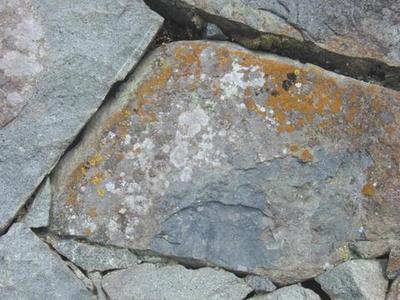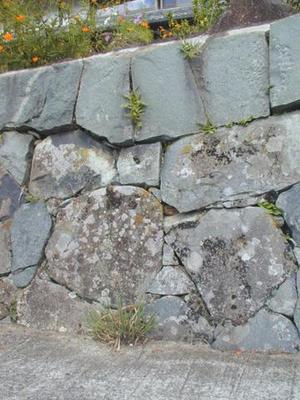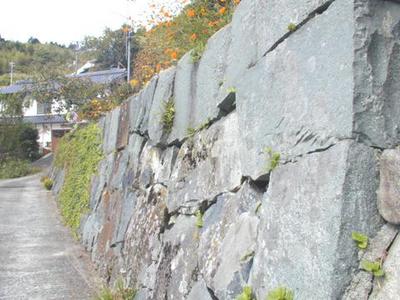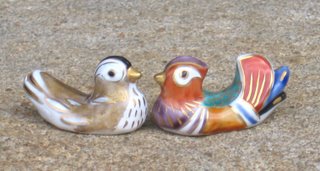:::::::::::::::::::::::::::::::::::::::::::::::::::::::::::::::::::::::::::::::::::::::::::::::::::::
石垣に蜻蛉の蔭の踊りかな ishigaki ni tonbo no kage no odori kana  old stone wall - the dancing shadows of dragonflies  alte Steinmauer - die tanzenden Schatten der Libellen  |
:::::::::::::::::::::::::::::::::::::::::::::::::::::::::::::::::::::::::::::::::::::::::::::::::::::
I could not catch the shadows, but I can show you our old stone wall.
Dragonfly (tombo, tonbo) Japan , Kigo in the Database
:::::::::::::::::::::::::::::::::::::::::::::::::::::::::::::::::::::::::::::::::::::::::::::::::::::
:::::::::::::::::::::::::::::::::::::::::::::::::::::::::::::::::::::::::::::::::::::::::::::::::::::
STONE WALL, ishigaki 石垣
a TOPIC for HAIKU
Look at some of my photos!
old stonewalls
flanked by cherry blossoms -
the universe changes
Stone Castle Wall and Cherry BlossomsTsuyama Castle
Castle Wall of Fukuyama Castle
:::::::::::::::::::::::::::::::::::::::::::::::::::::::::::::::::::::::::::::::::::::::::::::::::::::
- quote -
ishigaki 石垣 A dry stone wall.
A retaining stone foundation wall built without binding materials over an inclined earthen embankment. Originally intended to hold a castle embankment in place, the embankment and stone wall together were expected to provide a solid foundation for timber superstructures. When gates, towers and walls came to be built on the embankment, the ishigaki took on a multitude of functions, forming the base and sides of the gates and towers themselves, as well as the foundations for the donjon and moat.
The most frequently used stone for castle walls was andesite anzangan 安山岩, granite kakougan 花崗岩, quartz porphyry sekieihangan 石英斑岩、and gneiss henmagan 片麻岩. Andesite and granite are easy stones to work, and were widely used in Edo period castles.
The best stones for castle walls are considered to be shaped like a short square pillar, roughly two to three times as high as their base length. This type of stone is known as hikae 控え.
The length of a stone is called ishi-no-hikae 石の控え, and the width of the rock face visible on the wall surface is called ishizura 石面 or tsura 面.
A distinction is made between corner stones sumi-ishi 隅石 and those not at corners hira-ishi 平石 or tsuki-ishi 築石. The stones are often named according to their shapes or the way they have been cut.
For example a stone narrowing at one end is called kenchi-ishi 間知石, a cobble stone *tama-ishi 玉石, a chestnut stone used to fill small gaps *kuri-ishi 栗石, hewn stone kiri-ishi 切石, and rough stone *no-ishi 野石. There are a variety of building styles depending on the degree to which the stones are cut and prepared. Some of these styles, in order from the least worked to the most worked stones, are random masonry *ransekizumi 乱石積、burdock masonry *gobouzumi 牛蒡積, natural face masonry *nozurazumi 野面積, pounded and inserted masonry *uchikomihagi 打込矧ぎ, cloth construction *nunozuki 布築, cut inserted masonry *kirikomihagi 切込矧ぎ and tortoise-shell masonry kikkouzumi 亀甲積. Another method of construction, sangizumi 算木積, uses wooden logs to stabilize the stones.
Generally the surface stones of the wall are laid over a base of progressively smaller stones, pebbles, sand and earth to provide greater stability. In wet areas, the foot of the wall rests on a base supported by wooden stanchions to prevent collapse. The angle of the wall's incline varies with the height of the wall: the greater the height, the less steep the incline. According to Ogyuu Sorai's 荻生徂徠 (1666-1728) KENROKU 鈐録 (1727), there are three main shapes of castle wall: 1 walls of 45 degree elevation, called narashi ならし, in which only the topmost stone is completely vertical; 2 walls with a 50 degree elevation and the top 20% vertical; and 3 walls with an incline of about 80 degrees. The wall slopes upwards in a concave curve, with the top 25% completely vertical. Type two are usually pounded and inserted walls uchikomihagi, while type three are cut and inserted masonry kirikomihagi.
The slope of a stone wall is called ishigaki-no-koubai 石垣の勾配 (kobai) or ishigaki koubai 石垣勾配、and the joints between the stones are called meji 目地.
- source: JAANUS : ishigaki 石垣
:::::::::::::::::::::::::::::::::::::::::::::::::::::::::::::::::::::::::::::::::::::::::::::::::::::
. Edo shokunin 江戸の職人 Edo craftsmen .
ishi ku, sekkoo 石工 stone mason

Special groups made the stone walls, others carved stone statues and many more did grave stones.
Stone monuments for temples and shrines were called
miyamono 宮物.
Working on a stone monument with hammer and chisle produced a lot of stone dust and many masons suffered from lung diseases. So the eldest son of a mason was offen assigned different work, and the second and third sons had to do the dusty parts.

source : p.twipple.jp
Cutting stone for a castle wall
and its transportation
:::::::::::::::::::::::::::::::::::::::::::::::::::::::::::::::::::::::::::::::::::::::::::::::::::::
Yellow maple leaves
Crunching and browning on road
Stone wall gently curves
Look also at the photo here
©2007 barbara
:::::::::::::::::::::::::::::::::::::::::::::::::::::::::::::::::::::::::::::::::::::::::::::::::::::
autumn afternoon
hole in the stone wall
a perfect frame
© Nathaniel B. Gach, 2000, USA
:::::::::::::::::::::::::::::::::::::::::::::::::::::::::::::::::::::::::::::::::::::::::::::::::::::
springtime
a couple of chipmunks
in the stone wall
© Kirsty Karkow
Shorelines: Haiku, Haibun and Tanka
:::::::::::::::::::::::::::::::::::::::::::::::::::::::::::::::::::::::::::::::::::::::::::::::::::::
ishikirizushi ishikiri sushi 石切ずし "stone cutters sushi"
stone masons sushi
From Shodoshima. The stones of this island were cut and transported to Osaka for the construction of Osaka Castle. Now this famous sushi is prepared for festivals or memorial services.
. . . CLICK here for Photos !
石工の鑿冷したる清水かな
sekkoo no nomi hiyashitaru shimizu kana
fresh spring water
cools the chisel
of the stone mason . . .
Written in 1768
. Yosa Buson 与謝蕪村 in Edo .
:::::::::::::::::::::::::::::::::::::::::::::::::::::::::::::::::::::::::::::::::::::::::::::::::::::
. Wall, walls (kabe) and haiku
[ . BACK to WORLDKIGO TOP . ]
[ . BACK to DARUMA MUSEUM TOP . ]
:::::::::::::::::::::::::::::::::::::::::::::::::::::::::::::::::::::::::::::::::::::::::::::::::::::








13 comments:
Gabi, what beautiful photos...
I love the shapes, colors and textures of the stone wall.
Thank you for sharing.
mountain home . . .
a dragonfly darts along
the old stone wall
Carol Raisfeld
::::::::::::::::::::::::::::::::::::::::::::::::::::::::::::::::::::::
Thank you Gabi san for the beautiful Haiku and photos.
sunlight sways
on the stone wall ~ an ant
colony reaches home
moss wall
dew-drop worlds sparkle
a temple bell ~
Narayanan Raghunathan
::::::::::::::::::::::::::::::::::::::::::::::::::::::::::::::::::::::
Hi Gabi:
Lovely contrast of textures: stone, dragonfly, and the shadow where they meet.
Best,
B.
::::::::::::::::::::::::::::::::::::::::::::::::::::::::::::::::::::::
影連れて
トンボ去りけり
石無言
with it's shadow
a dragonfly gone
the stone silent
sakuo.
stone path --
just ahead of my shadow the red dragonfly's
shadow puppets:
the dragonfly's wings disappear!
(I remember walking along this wall at Gokurakuan.)
The misty morning walks held for me a surreal enchantment. The
shrill of the cicadas seemed as a chant.
bow
Chibi
http://groups.yahoo.com/group/cherrypoetryclub/message/25227
...................................
Thanks so much for your memories, Chibi san !
GABI
::::::::::::::::::::::::::::::::::::::::::::::::::::::::::::::::::::::
How lovely! Beautiful rich colour, Gabi.
I really love old stones and rocks. These are so inviting.
K.
I like this very much, Gabi. I see sunlight, the wall holding the warmth and the dragonflies so shiny in the sunlight that it's easier to see their shadows dancing on the wall than the quick creatures themselves.
The play of the shadows on that wall is mesmerising. The receptive stillness of stone. Somehow this haiku gives me a relaxed feeling.
L.
......................................................................
.
stone wall -
the spring wind fills
all the cracks
--Dana-Maria Onica
http://tinywords.com/haiku/2008/03/17
comments on facebook
Legends from 石垣市 Ishigaki town, Okinawa
32 to collect
.
Legend from Okayama 岡山県
yakoo no tama 夜光の玉 a ball of light in the night
According to the geographer 古川古松軒 Furukawa Koshoken,
in the year 1797 in 備前国 Bizen in 児嶋 / 児島 Kojima 榧原 Kayahara, a rich farmer had ishigaki 石垣 a large stone wall built around his estate. From two large stones there were two round balls coming out.
The big one looked as if a white powder was painted around it. When placed into a dark room, one could almost read a book.
.
https://edoflourishing.blogspot.com/2020/02/harima-kaido.html
.
sekkoo 石工と伝説 Legends about Sekko, stone masons
.
https://heianperiodjapan.blogspot.com/2021/04/sekko-stone-mason-legends.html
.
Post a Comment